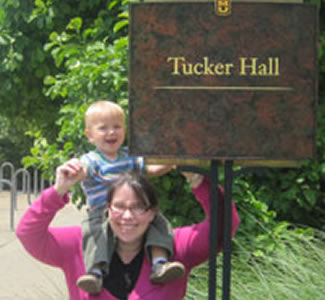
Pamela Brown
Associate Professor of Biological Sciences
Biological Sciences,
brownpb@missouri.edu
573-884-0214
Research summary
Molecular basis for polar growth in Agrobacterium tumefaciens
Research description
POSITIONS AVAILABLE:
Postdoctoral scholar, graduate student, laboratory technician, and undergraduate student positions available now. Email resume to brownpb@missouri.edu
My lab is interested in understanding the principles that govern bacterial morphology, a readily observable facet of microbial cell biology. One of the major unsolved questions in microbiology is how bacteria generate specific shapes. Bacteria exhibit an amazing diversity of shapes and sizes that are precisely reproduced at every generation, indicating that morphology plays an important role in the life of these bacteria (Figure 1). Impressive progress has been made in the past few years in understanding the mechanism of cell shape determination in a few model bacterial systems, including the discovery that bacteria possess a cytoskeleton, but we are still very far having a comprehensive understanding of how bacterial morphologies are generated. My lab takes advantage of recent technical advances in microscopy, construction of fluorescent fusion proteins, and high throughput sequencing, to make strides in understanding how bacteria generate specific morphologies.
In most bacteria, the cell wall is comprised of peptidoglycan and is a major determinant of cell shape. In a majority of rod-shaped bacteria, including E. coli, cells elongate by the lateral insertion of newly synthesized peptidoglycan along their sidewalls. In contrast, some rod-shaped bacteria utilize precise targeting of peptidoglycan to specific polar locations to enable cell elongation. Indeed, we have previously shown that constrained polar growth is responsible for elongation in many species of Rhizobiales, including Agrobacterium tumefaciens. My lab uses A. tumefaciens, a well-studied plant pathogen and causative agent of crown gall disease, as a model to understand how bacteria constrain peptidoglycan synthesis to specific cellular localizations. Presently, we are focused on addressing two key questions:
What is the mechanism underlying polar growth of A. tumefaciens?
What are the ecological and evolutionary benefits imparted by polar growth?
Knowledge gained though these studies will then be applied to enhance our understanding of the precisely targeted growth in other Alphaproteobacteria, including those that display remarkable morphologies. Our goal is to better understand the role of zonal peptidoglycan synthesis in generating both relatively simple and dramatically complex bacterial shapes.
Select Publications
C. Jiang, P.J.B. Brown, A. Ducret, and Y.V. Brun. 2014. Sequential evolution of bacterial morphology by co-option of a developmental regulator. Nature. doi:10.1038/nature12900
D.T. Kysela*, P.J.B. Brown*, K.C. Huang, Y.V. Brun. 2013. Biological Consequences and Advantages of Asymmetric Bacterial Growth. Annu Rev Microbiol. 67: 417-435.
A. Sims, Y. Zhang, S. Gajaraj, P.B. Brown, and Z. Hu. 2013. Towards the development of microbial indicators for wetland assessment. Water Res. 47:1711-1725.
Z. Wan, P.J.B. Brown, E.N. Elliott, and Y.V Brun. 2013. The adhesive and cohesive properties of a bacterial polysaccharide adhesion are modulated by a deacetylase. Mol Microbiol. 88:486-500.
S.M. Madren, M.D. Hoffman, P.J.B. Brown, David T. Kysela, Yves V. Brun, and Stephen C. Jacobson. 2012. Microfluidic device for automated synchronization of bacterial cells. Anal Chem., in press.
V.R. Pejaver, J. An, S. Rhee, A. Bhan, J.-H. Choi, B. Liu, H. Lee, P.J. Brown, D. Kysela, Y.V. Brun, and S. Kim. 2012. GeneclusterViz: a tool for conserved gene cluster visualization, exploration, and analysis. Bioinformatics 28(11):1527-1529.
P.J.B. Brown, M.A. DE Pedro, D.T. Kysela, C.V.d. Henst, X. DeBolle, C. Fuqua, and Y.V. Brun. 2012. Polar growth in Alphaproteobacteria. Proc Natl Acad Sci. 109(5):1697-1701. Science Editor’s Choice Highlight: 2012. Live to divide another way. Science. 335:775.
E. Kuru, H.V. Hughes, P.J. Brown, E. Hall, S. Tekkam, F. Cava, M.A. de Pedro, Y.V. Brun, and M.S VanNieuwenhze. 2012. In situ probing of newly synthesized peptidoglycan in live bacteria with fluorescent D-amino acids. Angew Chem. 51:12519- 12523.
G. Li*, P.J.B. Brown*, J.X. Tang, J. Xu, E.M. Quardokus, C. Fuqua and Y.V. Brun. 2011. Surface contact stimulates the just-in-time deployment of bacterial adhesions. Mol Microbiol. 83(1):41-51. (*equal contributions) Featured article: See Microcommentary by C.L. Kirkpatrick and P.H Viollier. 2012. Reflections on a sticky situation: how surface contact pulls the trigger for bacterial adhesion. Mol Micro. 83:7-9.
Chertkov, O., P.J.B. Brown, D.T. Kysela, 18 authors, H.-P. Klenk, Y.V. Brun. 2011. Complete genome sequence of Hirschia baltica type strain (IFAM 1418T). Standards in Genomic Sciences 5(3):287-297.
P.J.B. Brown*, D.T. Kysela*, and Y.V. Brun. 2011. Polarity and the diversity of growth mechanisms in bacteria. Semin Cell Dev Biol. 22(8):790-798. (*equal contributions)
P.J.B. Brown, D.T. Kysela, A. Buechlein, C. Hemmerich, and Y.V. Brun. 2011. Genome sequences of eight morphologically diverse Alphaproteobacteria. J. Bacteriol. 193:4567-4568.
M.L. Kovarik, P.J.B. Brown, D.T. Kysela, C. Berne, A.C. Kinsella, Y.V. Brun, and S.C. Jacobson. 2010. Microchannel-Nanopore Device for Bacterial Chemotaxis Assays. Anal Chem 82:9357–9364.
G.G. Hardy, R.C. Allen, E. Toh, M. Long, P.J.B. Brown, J.L. Cole-Tobian, Y.V. Brun. 2010. A localized multimeric anchor attaches the Caulobacter holdfast to the cell pole. Mol Microbiol. 76:409-427.
Selected honors and awards
College of Arts and Science Purple Chalk Teaching Award 2015
Ruth L. Kirschstein National Research Service Award Postdoctoral Fellowship 2007
University of Georgia Outstanding Graduate Research in Life Sciences Award 2006
University of Georgia Outstanding Teaching Assistant Award 2004
Joy Williams Porter Graduate Fellowship Recipient 2003
Achievement Rewards for College Scientists (ARCS) Fellowship Recipient 2002
University of Georgia Presidential Fellow 2000
